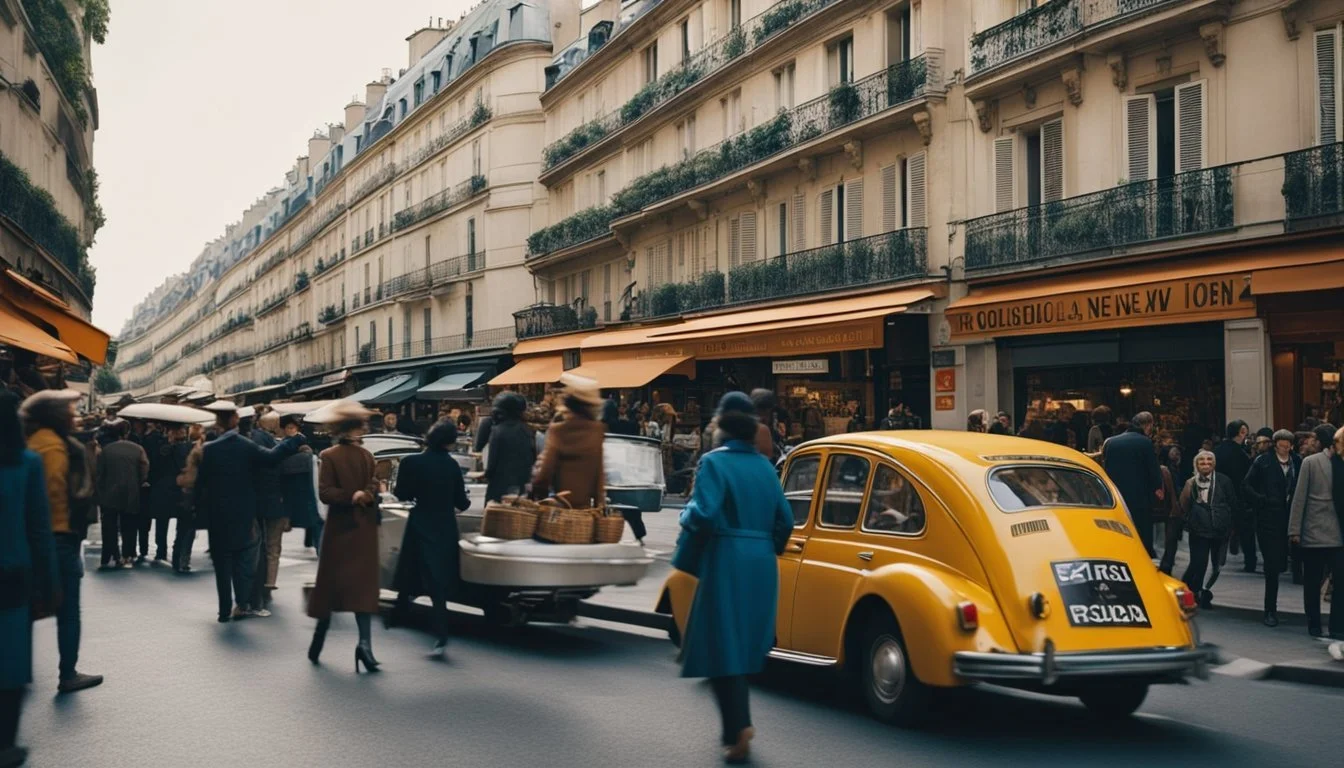Agnès Varda: Poetic Visionary of the French New Wave's Artistic Renaissance
Agnès Varda, often celebrated as the "Godmother of the French New Wave," carved a niche for herself in the cinematic world with her distinct, poetic vision. Beginning with her debut film "La Pointe Courte" in 1955, Varda's work broke away from conventional filmmaking, fostering a style that beautifully merged reality with art. Her films are not merely stories but a flow of visual poetry that captures the essence of human experience.
A central figure in the French New Wave movement, Varda's cinematic influence is profound and enduring. Her works such as "Cleo from 5 to 7" and "Vagabond" explore themes of feminism, identity, and existentialism, reflecting her deep empathy and keen observational skills. Varda's unique approach to storytelling—combining documentary realism with lyrical elements—set her apart in a predominantly male industry.
Her persistent spirit and innovative techniques continue to resonate, inspiring new generations of filmmakers. Varda’s legacy is a testament to the power of originality and artistic integrity in cinema.
The Early Life of Agnès Varda
Agnès Varda's early life set the foundation for her unique vision and groundbreaking contributions to cinema. Her background in photography and formative experiences in education played crucial roles in shaping her artistic path.
Birth and Education
Agnès Varda was born on May 30, 1928, in Ixelles, Belgium. Her birth name was Arlette Varda. She was the daughter of a Greek father and a French mother, giving her a diverse cultural background. When she was young, her family moved to Sète in the south of France.
In her early years, Varda attended the Lycée Victor Hugo in Sète and completed her high school education in Paris. Following this, she studied at the École du Louvre with a focus on Art History, further deepening her appreciation for the visual arts.
Photography and Early Career
Before turning to film, Varda embarked on a career in photography. She worked as a photographer for the Théâtre National Populaire in Paris, capturing influential images of stage performances. This experience sharpened her eye for composition and narrative in visual media.
Her first exhibition of photographs was held in 1954. Around the same time, she began exploring filmmaking, seeing it as a natural extension of her photographic work. This shift led to the creation of her first feature film, "La Pointe Courte," in 1955, marking the beginning of a long and influential career in cinema.
Emergence in French New Wave
Agnès Varda's entrance into the French New Wave began with La Pointe Courte, a film that marked her first major work. She solidified her place with Cleo from 5 to 7, which gained international acclaim and established her as a key figure in the movement.
La Pointe Courte: A Cinematic Debut
La Pointe Courte, released in 1955, represents Agnès Varda's entry into the world of cinema. With a background in photography, Varda brought a unique visual aesthetic to the film. The movie combined documentary-style realism with a narrative love story, setting the stage for themes and styles that would define the French New Wave.
Despite its low budget, the film's innovative approach to storytelling and editing garnered attention. By focusing on the lives of ordinary people and employing visual experimentation, Varda anticipated the techniques used by her contemporaries.
This debut not only showcased her talent but also challenged traditional filmmaking conventions, contributing to the broader movement.
Cleo from 5 to 7: Breakthrough into Fame
Cléo from 5 to 7, released in 1962, cemented Varda's reputation as a pioneering filmmaker. The film follows Cleo, a young singer, over two hours in real-time as she awaits a medical diagnosis. Its narrative structure, blending real-time progression with existential themes, was groundbreaking.
The film's visual style, including innovative camera work and attention to Parisian street life, exemplified Varda's poetic vision. The use of mirrors and reflections to explore identity further highlighted her creative artistry.
By intertwining personal and societal reflections, the film gained critical acclaim and brought Varda international recognition, solidifying her place in cinema history.
Thematic Elements and Styles
Agnès Varda's films are renowned for their deep engagement with realism, a commitment to feminist themes, innovative documentary techniques, and a unique visual aesthetic. These elements combine to create a storytelling style that is both intimate and expansive.
Realism and Feminism
Varda's work often explores everyday realities and features strong, complex female characters. In films like "Cléo from 5 to 7," she depicts the inner world of women, challenging traditional gender roles. The narrative follows Cléo, a woman waiting for medical results, capturing her vulnerabilities and strengths in a real-time format. Varda's feminism is also evident in "One Sings, the Other Doesn't," which portrays women's liberation and solidarity over many years. These films pioneer a feminist perspective, emphasizing personal and societal struggles.
Documentary Techniques
Varda frequently blurred the lines between fiction and documentary, beginning with her debut film, "La Pointe Courte." She utilized real locations and non-professional actors to enhance authenticity. In "The Gleaners and I," Varda included herself in the narrative, creating a personal connection with subjects and viewers. Her approach to documentaries was highly innovative, employing techniques like direct interviews, voice-over commentary, and blending personal reflection with broader social issues. This method gave her films a distinct voice, making them relatable and poignant.
Visual Aesthetics and Storytelling
Visually, Varda’s films are marked by vibrant colors, creative compositions, and symbolic imagery. She used these elements not just for aesthetic pleasure but to bolster narrative depth. For instance, "The Beaches of Agnès" employs mirrors and archival footage to reflect Varda's life journey, merging past and present seamlessly. Her use of symbolism, such as the heart motif in "Le Bonheur," adds layers of meaning to the narrative. Each visual choice is deliberate, guiding the viewer's experience and understanding of the story.
Influence and Collaborations
Agnès Varda's influence extends to both her contemporaries and modern directors. Equally notable are her numerous successful collaborations that significantly shaped her creative journey.
Contemporary Directors
Varda left a lasting mark on both her peers and later generations of filmmakers. Numerous contemporary directors have cited her as a pioneering force. Martin Scorsese, for instance, praised her unique visual storytelling. Quentin Tarantino has also acknowledged her role in shaping narrative structures in modern cinema.
In addition to these prominent voices, many independent filmmakers draw inspiration from her blending of documentary realism with poignant fiction. Her innovative techniques in films like Cléo from 5 to 7 set a new standard in cinematic expression. Varda's work resonates with directors emphasizing personal, socially conscious narratives.
Collaborative Works
Collaboration played a key role in Varda's career. One notable partnership was with her husband, Jacques Demy. Their artistic union resulted in films that complemented and contrasted each other’s styles. Varda's Jacquot de Nantes is a heartfelt homage to Demy’s childhood and early cinematic influences.
She also worked with other French New Wave figures like Jean-Luc Godard. Her film Les Fiancés du Pont Macdonald featured Godard and Anna Karina, symbolizing a close-knit community of artists.
In later years, Varda's collaboration with street artist JR in Faces Places highlighted her continued relevance and adaptability. Their joint project bridged generational gaps, blending Varda's humane vision with JR's contemporary art.
Later Works and Projects
In Varda's later career, she continued to innovate with a focus on personal storytelling and the use of digital media. These projects combined her distinct perspective with new technology, enriching the documentary genre.
The Gleaners and I: A Turn to the Personal
The Gleaners and I (2000), one of Varda's most acclaimed later works, epitomizes her shift towards deeply personal and introspective filmmaking. The documentary explores the concept of gleaning, which refers to the act of collecting leftover crops from fields after the commercial harvest. Varda extends this idea metaphorically to modern society, focusing on people who repurpose discarded objects.
Varda herself appears in the film, making it not only a social commentary but also a personal diary. Her presence adds a layer of intimacy, as she shares her own reflections alongside those of her subjects. The documentary's use of a handheld digital camera enabled Varda to shoot spontaneous and candid moments, enhancing the film's authenticity and warmth.
Digital Cinema and Multimedia
Embracing digital technology allowed Varda to continue creating well into her later years. Her innovative use of digital cameras and editing software enabled more flexibility and spontaneity in her work. Digital cinema played a crucial role in Varda's project, The Beaches of Agnès (2008), a self-retrospective film that combines clips from her previous works with new footage.
Varda also explored multimedia art installations, merging film with other visual arts. Exhibitions like L'Île et Elle (2006) transformed her filmmaking into immersive experiences, using digital projections and mixed media to surround viewers with Varda's unique vision. These projects showcased her ability to adapt and evolve, utilizing new tools to expand her storytelling toolkit.
Varda's later works highlight her adaptability and innovative spirit, maintaining her influence on contemporary cinema while exploring new artistic horizons.
Recognition and Awards
Agnès Varda, often hailed for her pioneering contributions to the French New Wave, received numerous accolades throughout her illustrious career. Highlighting her recognition at international festivals and by the Academy, this section underscores the significant honors that cemented her legacy.
Festival Honors
Agnès Varda's work was celebrated at prestigious film festivals worldwide. Cleo from 5 to 7 earned her critical acclaim and numerous awards, contributing to her reputation as a leading filmmaker in the French New Wave.
At the Venice Film Festival, she received the Golden Lion for Vagabond in 1985, showcasing her ability to craft profound narratives. Her short film Black Panthers also won accolades at several international festivals, proving her versatility across different forms of filmmaking.
Another significant recognition came from the Cannes Film Festival where she was awarded the Caméra d'Or in 1985 for her contributions to cinema. In 2015, Cannes honored her with the honorary Palme d'Or, making her the first female director to receive this honor, recognizing her lifelong dedication and impact on the film industry.
Academy Recognition
Varda's contributions were also acknowledged by the Academy of Motion Picture Arts and Sciences. In 2018, she was honored with an Honorary Oscar, highlighting her innovative achievements and lasting influence on the art of filmmaking.
This accolade recognized her body of work, including seminal films like La Pointe Courte and The Gleaners and I.
Her Oscar nod was significant, as it underscored the rise of recognition for female directors in an industry historically dominated by male voices. This award was a tribute not only to her filmography but also to her role as a trailblazer for future generations of filmmakers.
Her legacy thus continues to inspire and influence new creators in the ever-evolving landscape of cinema.
Legacy and Influence on Modern Cinema
Agnès Varda's innovative approach to storytelling and her focus on personal, feminist, and often political themes have left a lasting legacy. This section explores the tributes paid to her and how her influence persists in contemporary cinema.
Tributes and Homages
Agnès Varda's passing was marked by worldwide recognition of her contributions to cinema. Publications celebrated her as the "grandmother of the New Wave" and noted her pioneering work in feminist filmmaking.
Filmmakers and critics alike have praised Varda, and retrospectives of her work have been held in major film festivals, such as Cannes and Venice.
Moreover, prominent directors like Martin Scorsese and Greta Gerwig have cited Varda as an inspiration, illustrating her impact across generations of filmmakers.
The Varda Wave: Continuing Impact
Varda's influence can be seen in the works of contemporary directors who incorporate personal narratives and blend documentary with fiction, mirroring her style.
Her technique of using real locations, non-professional actors, and her poetic visual language continues to inspire. Directors like Céline Sciamma and Lulu Wang often reference Varda's contribution to feminist cinema.
Her films also serve as teaching material in film schools, ensuring that her innovative methods are passed on to future generations. Varda's legacy endures, shaping the landscape of modern cinema with her inventive storytelling and distinctive vision.




